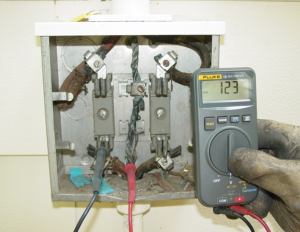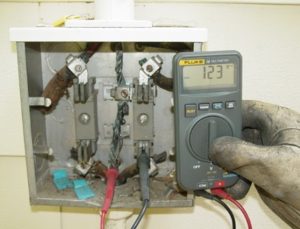The Meter Base Checkout Procedure
To emphasize the critical importance of the meter base checkout procedure, this installment of “Voice of Experience” will cover the proper procedures for (1) checking out a meter base before setting a self-contained meter on new services and (2) resetting a meter after it has been removed and the base has not been in use.
This article will also provide guidance on the worst-case scenario, which involves reconnecting a disconnected meter. This task, while rare, requires the utmost caution and adherence to safety guidelines. Understanding and preparing for this scenario is crucial for your safety and the safety of others.
Proper training should be completed before a worker is instructed to set a self-contained meter. Personal injury and damage to a customer’s property could occur if the recommended procedures covered in this article are not followed.
Avoiding an Incident
I want to begin by highlighting an issue that was discovered using the checkout procedure.
 |
 |
As you can see in the photos above, voltage was found on the load side of a meter base that had been disconnected in the past. Neighbors had provided service through an extension cord improperly connected to the home. This is one of many cases in which a worker who performed the proper meter base checkout procedure identified an issue, thereby avoiding a flash incident.
Unfortunately, sometimes the procedure is not used when necessary, which has led to catastrophic results on more than one occasion. I’m aware of a house that caught fire, an employee who suffered an arc flash incident, and a number of other ugly outcomes that I don’t have the time or space to mention in this article. These instances underscore the potential risks of neglecting the meter base checkout procedure.
Remember, the test-and-verify approach is not just a philosophy – it’s a necessity. Regardless of your expertise or years of experience, mistakes can be made. You should never make assumptions that everything is OK. The best approach is to take all measures of prevention and verification when setting a meter. It’s not just about doing the job; it’s about doing the job right, every time. And the right way to begin is by following the meter base checkout procedure.
Personal Experience
I first discovered the concept of proper procedures when I was just a young apprentice learning the trade. There were no OSHA regulations at that time; all we had was a company safety rule book that we didn’t read as much as we should have. Tasks were often learned in the field through watching others who supposedly knew how to perform those tasks safely. Most of the time, things went OK, thank goodness. But occasionally, I would discover that training was needed based on outcomes. At one point, I was the young apprentice on what we called the “Cut-In/Cut-Out Crew,” which consisted of me and a lineman who ran services and answered light calls. Once, at a new house, we opened the transformer switch and installed the #2 triplex service. We had the order and electrical permit, and everything was ready so that we could set the meter. We ran the service. I checked the line-side blocks of the 200-amp meter base, 120 on each leg, 240 volts across the lugs. I took the meter, set it in the load-side lugs, pushed it into the line-side lugs, and boom! It did not blow transformer fuses; a 5-amp Kearney can handle a lot of fault current. However, I found out later that the entrance cable in the wall had a Sheetrock nail or two driven in between the meter and the panel just inside the utility room. If I had used the meter base checkout procedure, I would have seen the dead short to ground on hot legs. Instead, a terrible arc in the utility room blew the Sheetrock open and insulation out of the floor. I left that day with a lesson learned: Regardless of the situation, check out the meter base for shorts and faults.
Later, a meterman named Jack Petty wrote a procedure that would eventually become a policy to identify shorts and loads on a meter base before installing a meter or reconnecting a meter to restore service. There are many reasons to use the procedure. For example, customers use illegal methods to steal electricity, and neighbors will pull extension cords next door to restore power when a meter is disconnected or partially removed. An unknown load on a meter could cause a fire when combustible material is left on an electric range and service is restored. It could also burn up a water heater that has no water service. Vacation homes in the South are often left vacant during the summer, with owners returning for winter and getting their utilities reconnected. I’m aware of house fires and damaged appliances caused by such circumstances.
Large homes or businesses with parallel service for larger loads and multiple meter bases also require proper ringing out and verification to ensure markings are correct. Never trust that a cable tag is correct. The tag can be improperly marked, or on some occasions, there may be no tag at all. Flashes and equipment damage have been caused by underground distribution services when the correct cables for disconnection were not identified. I have investigated multiple cases of this.
The Proper Method
The proper method for checking out a single-phase meter base requires the following steps:
- The line to neutral on each line-side lug. This will indicate the correct phase-to-ground and phase-to-phase voltage.
- A test of the load-side lugs, line to line, should be made left-side load to neutral, right-side load to neutral on the load side to identify shorts or loads.
- Finally, checking each meter lug line side to load on each side of the meter base will identify the possibility of an unknown load or appliance in the house when using the correct meter.
If you would like more information, I have a diagram and a PowerPoint of the procedure that illustrate all the safe measures described here. Reach me at rainesafety@gmail.com.
A three-phase self-contained meter base would require additional steps to cover the additional lugs on the line and load side. Note that this article does not cover a transformer-rated CT meter base.
As noted earlier, failure to use these procedures has resulted in many incidents, and I can share those details with any readers who are interested.
My final thought: Never assume it is OK to set or connect services without testing and verifying that the electrician has completed all work correctly and confirming that no one has tampered with the service before setting or reconnecting a meter.
About the Author: Danny Raines, CUSP, is an author, an OSHA-authorized trainer, and a transmission and distribution safety consultant who retired from Georgia Power after 40 years of service and now operates Raines Utility Safety Solutions LLC.
Learn more from Danny Raines on the Utility Safety Podcast series. Listen now at https://utilitysafety.podbean.com!

